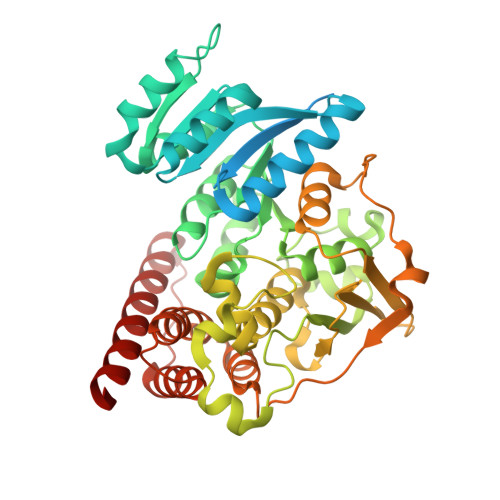Reverse N-Substituted Hydroxamic Acid Derivatives of Fosmidomycin Target a Previously Unknown Subpocket of 1-Deoxy-d-xylulose 5-Phosphate Reductoisomerase (DXR)
Abdullaziz, M.A., Takada, S., Illarionov, B., Pessanha de Carvalho, L., Sakamoto, Y., Hoefmann, S., Knak, T., Kiffe-Delf, A.L., Mazzone, F., Pfeffer, K., Kalscheuer, R., Bacher, A., Held, J., Fischer, M., Tanaka, N., Kurz, T.(2024) ACS Infect Dis 10: 1739-1752
- PubMed: 38647213
- DOI: https://doi.org/10.1021/acsinfecdis.4c00100
- Primary Citation of Related Structures:
9JOA, 9JOB - PubMed Abstract:
Reverse analogs of the phosphonohydroxamic acid antibiotic fosmidomycin are potent inhibitors of the nonmevalonate isoprenoid biosynthesis enzyme 1-deoxy-d-xylulose 5-phosphate reductoisomerase (DXR, IspC) of Plasmodium falciparum . Some novel analogs with large phenylalkyl substituents at the hydroxamic acid nitrogen exhibit nanomolar Pf DXR inhibition and potent in vitro growth inhibition of P. falciparum parasites coupled with good parasite selectivity. X-ray crystallographic studies demonstrated that the N -phenylpropyl substituent of the newly developed lead compound 13e is accommodated in a subpocket within the DXR catalytic domain but does not reach the NADPH binding pocket of the N -terminal domain. As shown for reverse carba and thia analogs, Pf DXR selectively binds the S -enantiomer of the new lead compound. In addition, some representatives of the novel inhibitor subclass are nanomolar Escherichia coli DXR inhibitors, whereas the inhibition of Mycobacterium tuberculosis DXR is considerably weaker.
Organizational Affiliation:
Heinrich Heine University Düsseldorf, Faculty of Mathematics and Natural Sciences, Institute of Pharmaceutical and Medicinal Chemistry, Universitätsstr. 1, 40225 Düsseldorf, Germany.


















